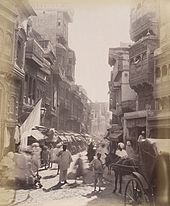The culture of Lahori People is a manifestation of the lifestyle, festivals, literature, music, language, politics, cuisine and socio-economic conditions of its people. It is characterised by the blending of South Asian, Middle Eastern, Central Asian and Western influences.
Lahore's culture is unique. It is sometimes referred as the cultural capital or the heart of Pakistan, the city was a seat of the Mughal Empire and the Sikh Empire as well as the capital of Punjab in Mahmud Ghaznavi's 11th century empire and in the British Empire. Presently, it is the capital of the Punjab province of Pakistan.
History of culture
Lahore has played an important role in Pakistani history. It was in this city that Pakistan's independence declaration was made. It was the largest city in the newly formed Pakistan at the time of independence and provided the easiest access to India, with its porous border near the Indian city of Amritsar only 30 miles (48 km) to the east. Large numbers of Hindus, Sikhs, and Muslims lived closely in Lahore before the independence of Pakistan.
The city suffered revolts, demonstrations and bloodshed at the time of independence due to the enmity between Muslims and Hindus at the time and the uncertainty which loomed over the fate of Lahore even after India and Pakistan became independent. Lahore's culture, its history, institutions, food, clothing, films, music, fashion, and liberal community lifestyle attract people from all over the country.
The city has many significant connections with Sikhism and played an important part in the history of the Sikh Gurus. Guru Ram Das was born at Bazaar Chuna Mandi, Lahore in 1534 A.D. Guru Arjan Dev got the foundation stone of Harmandir Sahib, laid by a Muslim Saint Hazrat Mian Mir Ji of Lahore in December 1588. Guru Arjan met an untimely death when he was tortured on the orders of the Emperor Jahangir in 1606 in this city. The Gurdwara Dehra Sahib and the Samadhi (Mausoleum) of Ranjit Singh are located in Lahore.
Arts and architecture
Art of Lahore has a strong bearing upon the Mughal period. The historical monuments and buildings of Lahore stand as the specimen of Mughal art and architecture. However, the heritage also has a touch of Aryans, Arabs, Persians, British, Sikhs and Greeks.
Lahore Fort, Badshahi Mosque, Shalimar Gardens, Nur Jehan's Tomb, Tomb of Jahangir, Tomb of Anarkali, The Lahore Museum, Chauburji or Char Minar and Bagh-e-Jinnah are some the major architectural works found in Lahore. The palaces/havelis, forts, madrassas and mosques make the Lahore art known among the rest of the world.
The art galleries of Lahore also display a number of artefacts belonging to the Mughal period. Many contemporary artworks are also exhibited in the art galleries of the city.
In modern days, parts of Bahria Town Housing Scheme in Lahore are themed on ancient Egyptian culture. There are many other architectural notables, including themes for different locales that make Bahria a very interesting and well conceived scheme to visit and live in.
The World Performing Arts Festival is held every autumn (usually in November) at the Alhambra cultural complex, a large venue consisting of several theatres and amphitheatre. This ten-day festival consists of musicals, theatre, concerts, dance, solo, mime, and puppetry shows. The festival has an international character, with nearly 80 percent of the shows performed by international performers. On average 15–20 different shows are performed every day of the festival.
Lahore is also the centre of Pakistan's puppetry industry. Although not economically viable as a business, the Peerzada family like Faizan Peerzada has been arranging puppetry festivals for more than a decade, at one point even bringing the biggest festival in the world to Lahore.While, Ajoka Theatre and Independent Theatre Pakistan are the leading theatre companies in continuous production in Lahore.
Lahore's biggest contributor to the art scene is undoubtedly the National College of Arts, the country's, most prestigious art college, which has produced some of the country's most famous painters, writers, actors and musicians. There are also several art galleries throughout the city which hold exhibitions regularly among which the Drawing Room Art Gallery is the most popular.
Music and dance
Lahore has seen a myriad of melodies, genres, and vocals alongside a variety of musical instruments (both new and old) over the past few decades. This has given rise to the city’s diverse sound of music and rapidly evolving culture. Lahore's Music ranges from the earthy qawwalis of Nusrat Fateh Ali Khan, the Punjabi ditties of Abrar-ul-Haq, the pop sensations; Atif Aslam and Ali Zafar, the Sufi-Rock of Junoon, the underground Lahori grunge/rock revolution (of a handful of bands) in the early 90s and to the revolutionaries of yesteryear – Noor Jehan, Farida Khanum, Ustad Amanat Ali Khan and many more. In addition, the dhol maestro, Pappu Sain, and the master of the iktara, Saien Zahoor (both of whom have shared their glory performing for people at shrines to concerts), to the fresh crop of commercialised Lahori pop acts (of both the past and today), to the jaded, angst-ridden rockers/bands such as Shahzad Hameed, Call, and Entity Paradigm; music from Lahore has been assorted at best. In fact, the Lahori music scene has churned out so many musicians over the years that it would be almost impossible to list each band/musician down. Nonetheless, each has contributed to the country’s music scene on a macro level – making it what it is today; pulsating with promise.
Even though things have been on the down slide – given the worldwide economic recession and the security situation within the country – the local musicians have still managed to stay in the game by taking out albums (some of which are completely self-funded), and playing at concerts and gigs throughout the country.[5]
Lahore is also famously known in the Indian subcontinent for its mujra dance, which originated in the courts of the Mughals and has been passed on through successive generations by traditional women practitioners.




No comments:
Post a Comment